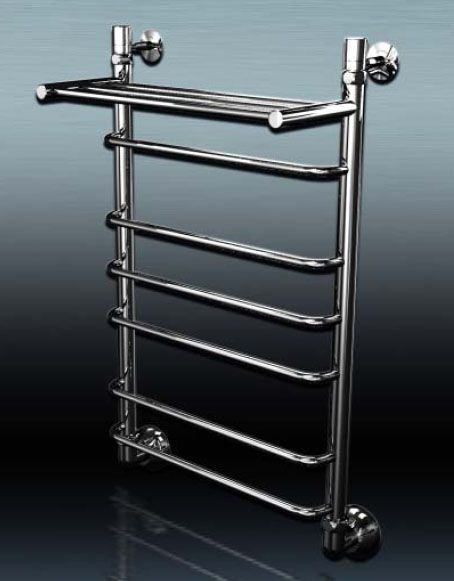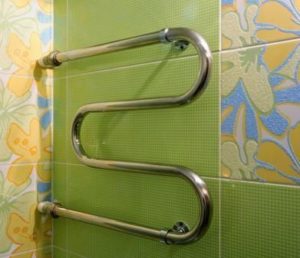How to choose an electric heated towel rail
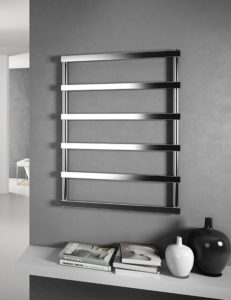 Installing a heated towel rail is an excellent solution if there is no heating radiator in the room. This is a multifunctional device that will help solve two issues at once: dry clothes and heat the room to a certain extent. An electric heated towel rail for the bathroom is very convenient. It operates all year round, is not connected to the heating system and is very easy to install. If recently, heated towel rails did not differ much from each other in terms of operating principle and design, today the variety of assortment will delight the most discerning customers.
Installing a heated towel rail is an excellent solution if there is no heating radiator in the room. This is a multifunctional device that will help solve two issues at once: dry clothes and heat the room to a certain extent. An electric heated towel rail for the bathroom is very convenient. It operates all year round, is not connected to the heating system and is very easy to install. If recently, heated towel rails did not differ much from each other in terms of operating principle and design, today the variety of assortment will delight the most discerning customers.
The content of the article
What types of heated towel rails are there?
There are various devices of this kind, differing in their technical and design features, as well as in the installation method.
- By type of coolant connection: water, electric and combined type devices.
- By size format: vertical and horizontal.
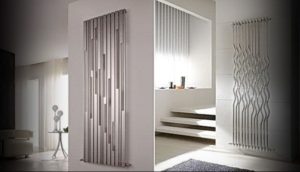
- By material of manufacture: aluminum, ceramic, steel and copper.
The main materials from which heated towel rails are made include: aluminum, ceramics, copper, ordinary steel and stainless steel. The durability, thermal characteristics and tactile qualities of a device of this type directly depend on the material from which the product was made. It is not recommended to choose devices made from low-carbon steel. This is a short-lived material and devices made on its basis begin to leak quickly. Devices made of non-ferrous metal (brass or galvanized copper) have a higher cost, but they also last much longer. High quality stainless steel appliances do not rust for up to 50 years of continuous use.
REFERENCE! The fewer connections there are on the heated towel rail, the less likely it is that defects will form at the welding points. Perfectly welded joints will be smooth to the touch.
Why choose an electric model
This type of heated towel rail consists of a curved pipe and a heating element connected to a source of electricity. Each model has its own connection nuances, depending on its structure. This type of device can be installed on the floor or attached to the wall.
If we compare electric models with water ones, the undoubted advantage of the former is considered to be a closed circuit. This means that the device can operate autonomously regardless of the availability of hot water in the house. In such systems there are no problems with pressure and air locks. Problems with using such a device may arise if there is a sudden power cut. But even despite this, devices of this kind have a significant advantage over water devices. Problems with power outages are usually resolved within 24 hours, while maintenance of water pipes can be carried out throughout all months of the summer.
Types of electric heated towel rails
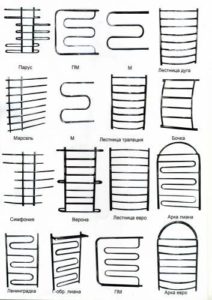 Electric heated towel rails can have a cable (“dry”), liquid (“wet”) or a combined design, depending on the filling of the pipes. Models with a “wet” design are heated using a coolant (water, oil or antifreeze), heated from the inside by a heating element. Essentially, it is a curved tube filled with warm liquid. Their operating principle is very similar to the functioning of electric heaters. Any of these coolant options has characteristic advantages and disadvantages. Water can heat up to a temperature of +85 °C, but at the same time it cools down quite quickly. A distinctive feature of antifreeze is considered to be high thermal conductivity. The oil retains heat for a long time after the power is turned off, but the maximum permissible temperature of oil heaters cannot exceed +80°C.
Electric heated towel rails can have a cable (“dry”), liquid (“wet”) or a combined design, depending on the filling of the pipes. Models with a “wet” design are heated using a coolant (water, oil or antifreeze), heated from the inside by a heating element. Essentially, it is a curved tube filled with warm liquid. Their operating principle is very similar to the functioning of electric heaters. Any of these coolant options has characteristic advantages and disadvantages. Water can heat up to a temperature of +85 °C, but at the same time it cools down quite quickly. A distinctive feature of antifreeze is considered to be high thermal conductivity. The oil retains heat for a long time after the power is turned off, but the maximum permissible temperature of oil heaters cannot exceed +80°C.
“Wet” models can be connected in two ways: to the central heating system and to the hot water supply system. It is not recommended to use the first option, since the operating time of such a device will be limited by the heating period.
The main advantage of models with a “wet” design is the ability to retain heat after turning off the power. The disadvantages include impressive energy consumption compared to heated towel rails with a “dry” design. Another significant disadvantage of “wet” models is the short service life of heating elements, since they wear out faster in liquid.
Heated towel rails with a “dry” type heating element are heated using a special insulated cable (the same cable is used in underfloor heating systems) and have a longer service life. As a rule, such products last 3–5 years longer than their “wet” counterparts.The duration of their operation largely depends on the materials and build quality of such devices. Heated towel rails with a “dry” design provide less energy consumption during operation, and their range is much wider.
It is recommended to purchase combined type models if you have the required amount of funds, since the cost of such heated towel rails is significantly higher. Such models operate both from the mains and from central heating. The main advantage of such devices is that they can operate from heating in the fall and winter, and in case of emergency situations when hot water is turned off, they can operate from the mains.
REFERENCE! Many of these models have a temperature controller, which can be mechanical or electronic.
If necessary, a water heated towel rail can be converted into a combined type system. To do this, you need to select a device model that is suitable in size and purchase a heating element of the appropriate power.
Criteria for choosing an electric heated towel rail
In order to understand which heated towel rail is better and not make a mistake when choosing and purchase the model that best suits your specific preferences, it is recommended to pay maximum attention to the following characteristics.
- Device power. This indicator should always be calculated so that 150–200 W of power is fully provided per square meter of bathroom. If you install an appliance that has insufficient power, the room will be too damp. A device with more power than recommended will cost several times more and will consume excessive power.
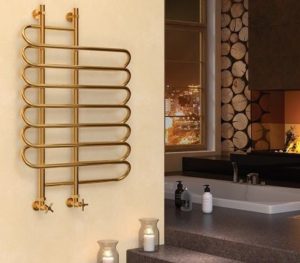
- Heating element type.In most cases, devices of this kind with “wet” or “dry” heating elements have the same power. You can see the difference only in the rate of heating and cooling. Although these indicators are not fundamental, they are still worth taking into account when choosing a suitable model.
- Economical. The energy consumption of different types of devices can vary significantly. Devices of this type are equipped with heating elements with a power of 100–2000 W. Powerful models are equipped with special sensors and automation that turns them off when a certain temperature is reached. Thanks to this feature, resources are spent more economically.
- The method for connecting the device to the network. Can be open or closed. Open differs in that in this case the wires leading from the device to the electrical outlet are located on the visible part of the wall. When closed, they will be securely hidden directly under the finishing elements. The first method is easier to connect devices, and the second is safer.
- Availability of additional features. If necessary, you can purchase a model equipped with a timer, thermostat, or other useful functions that facilitate the operation of the device.
When purchasing an electric heated towel rail, you need to check whether this model is compatible with the local electrical network (relevant for imported appliances). Otherwise, you will have to additionally acquire a special adapter.
A good-quality heated towel rail is a very useful component of the bathroom, especially important for those who have small children. Constant heating of the bathroom helps prevent the occurrence of dampness and condensation accumulation.As a result, mold and mildew, which can significantly worsen the condition of the finishing materials of the room and provoke respiratory diseases in residents, multiply much less. In addition, in the rating of modern models of such devices, there are unusual design solutions that can significantly transform the bathroom, becoming its most striking and noticeable part.




